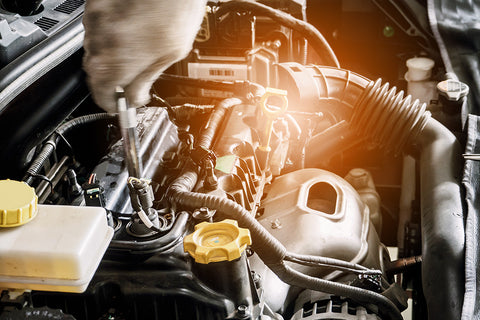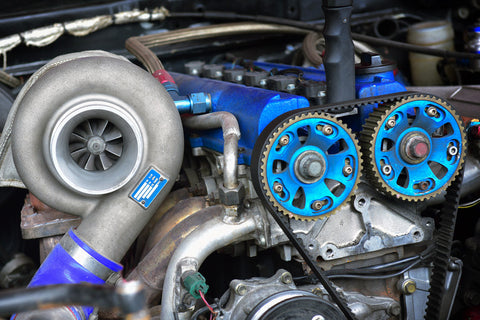Turbochargers are becoming more available in the automotive industry, especially with diesel vehicles. Turbochargers provide vehicles with a great performance boost. But are turbochargers illegal?
As with any other vehicle modification, there are laws and regulations that you must follow. These regulations vary based on the state in which you reside. You must check your state's laws regarding the part you wish to add to your vehicle before doing so.
So, let's see if turbochargers are legal.

Source: shutterstock.com/ Photo Contributor: Kwangmoozaa
Are Turbochargers Illegal?
Turbochargers are not illegal in the United States, as most diesel engines are designed to use a turbo. But their applications recently started expanding to gasoline engines.
While turbos are not illegal vehicle modifications, some laws and regulations vary from state to state. These are regarding:
Is Installing a Turbo Illegal: Regulations in the U.S.
Turbos are forced induction devices harnessing exhaust gasses to boost engine power. If you are looking for a turbocharger for sale, check us out. We offer high-quality new, used, and rebuilt turbos.
But on a more serious note now, how do you install a turbo?
You connect a turbocharger to an internal combustion machine. Turbos use the vehicle engine's output gas to spin a compressor wheel while collecting increased air from the outside.
This turbocharger enhances vehicles by producing more horsepower and torque in the engine.
Emissions regulations
As we mentioned, turbos force in more air into your engine to give it a power boost. But, this increased air may lead to increased emission output. As long as your vehicle complies with your state's vehicle pollution standards, you won't have any legal issues.
Check to confirm that your turbocharged engine complies with the emission standards and related vehicle modification requirements. The emission standards also vary on the type of vehicle you drive.
SUVs and cars have different emission standards than heavy-duty vehicles like trucks. The emission standards consider the size of the engine, the type of fuel the vehicle uses, etc.
In the United States, the Environmental Protection Agency (EPA) is the one regulating vehicle emissions. All new vehicles must follow the EPA's emission standards.
Original manufacturer OEM parts
If your vehicle's turbo is an original manufacturer part, there should be no legal troubles. With an OEM part, your vehicle should be legal on public roads.
We should note that you do not have to search for the exact same OEM part that your vehicle originally had.
Instead, you may look for upgraded pieces to replace the parts in your vehicle, but with original parts. Original manufacturer parts are valuable as they won't impact your vehicle's warranty or cause legal issues.

Source: shutterstock.com/ Photo Contributor: Iaroslav Neliubov
Date of vehicle manufacturing
This is another factor you may want to consider, especially if your vehicle is older. Older vehicles that are unaffected by state regulations are named "uncontrolled" vehicles. Check to see if your vehicle's manufacturing date is before your state's regulations.
If your vehicle's manufacturing date is before the emissions laws implementation, it is an "uncontrolled" vehicle.
Turbocharged Engine: Definition and Moving Parts
A turbocharger is an accessory installed in a car's engine, and such engines may raise performance and efficiency levels. This is why numerous automakers decide to turbocharge their cars.
A shaft connects the two sections that make up a turbo. Hot exhaust gases rotate a turbine on one side that is attached to another turbine, drawing air in and compressing it for the engine.
More fuel can be injected for more power as more air enters the combustion chamber. The compression is what provides the engine with extra strength and effectiveness.
Turbochargers have main and supporting components. The main components include the turbine, compressor, and center hub rotating assembly. In contrast, supporting components include an intercooler, water injection, wastegate, and blowoff valve.
The main performance components of turbos
Turbine
The turbine is a part of the turbo known as the exhaust side. The turbine produces the rotational force needed to power the compressor. The performance of the turbo is tied to its size and also the relative size of the turbine wheel.
Larger turbines require higher exhaust fuel flow rates, increasing the performance boost threshold. In contrast, smaller turbines may produce the performance boost faster and at lower fuel flow rates.
Compressor
The compressor is the component that draws in outside air through the engine's intake system. Once inside, the compressor pressurizes and feeds the air into the combustion chambers. The compressor consists of an impeller, a diffuser, and a spiral housing.
Center hub rotating assembly
The center hub rotating assembly (CHRA) contains the shaft that connects the turbine with the compressor. The CHRA also has a bearing that allows the shaft to rotate at higher speeds with minimal friction.
Supporting performance components of turbos
The following components are usually used with turbocharges.
- Intercooler- a radiator that cools the intake air after being pressurized by the turbo
- Water Injection- sprays water into the combustion chamber to cool the intake air
- Wastegate- helps limit the amount of gases entering the turbine. This is important as too much boost pressure may damage the engine
- Blowoff Valve- a component that prevents compressor stall when the throttle is closed.
Difference Between Turbos and Superchargers
Besides its increased power, turbochargers are sometimes called "free power" generators. This is because, unlike superchargers, they run independently of the engine.
A turbocharger is powered by the hot, expanding gasses that exit the engine. This prevents the engine's net power depletion.
At higher altitudes, turbochargers are not impacted the same way as naturally aspirated engines. The thin atmosphere makes it more difficult for an NA engine to get oxygen as it ascends higher in altitude.
By forcing oxygen into the engine's combustion chambers, a turbocharger circumvents this issue. Both turbos and superchargers are forced induction systems. But the main difference between both is their power supply.
Superchargers contain belts that connect them directly to the engine. They essentially get power like a water pump. In contrast, a turbocharger gets power from the exhaust stream.
Turbochargers are more efficient as they use the "wasted" energy for power sources. Plus, turbos are more affordable than superchargers.

Source: shutterstock.com/ Photo Contributor: Sanit Fuangnakhon
Conclusion
So, are turbochargers illegal? The answer is no. Turbocharged engines are legal in the United States. But this is only as long as you use them in a way that does not violate emission regulations.
Before installing a turbo in your vehicle, be sure to check the regulations regarding turbos. You can also contact u with any questions you may have. We will make sure to help you understand everything about turbos.



